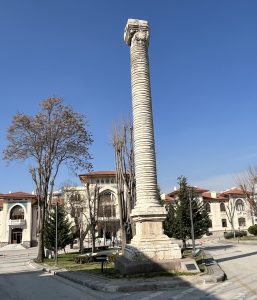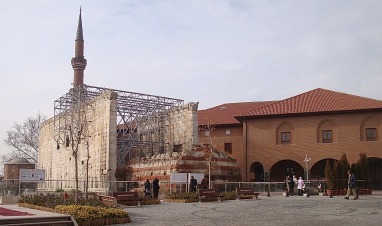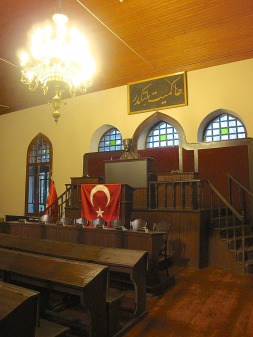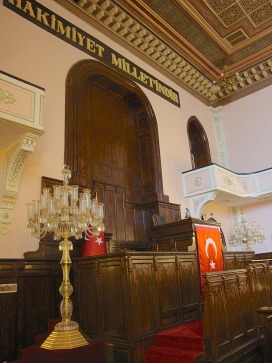“The Nation”
Ulus is the touristic heart of Ankara with its focal point at Heykel (Statue) which is named after a huge equestrian statue of Atatürk that dominates a major road junction. Technically this is the Zafer Anıtı (Victory Monument) but everyone calls it Heykel. It was constructed by the Austrian sculptor, Heinrich Krippel, in 1927 and its inscriptions are still written in Osmanlı since it went up before Atatürk’s enforced switch to the use of the Lain alphabet.
Until recently this was a distinctly seedy area with many gazinos (drinking dens) lurking in dimly-lit, rubbish-strewn back streets. This was always a pity not just because some of the best cheap hotels were here but also because it was by far the most interesting part of Ankara in terms of history and architecture. The good news is that belated regeneration work has started. Before long few visitors to Ankara will need to venture much beyond Ulus.
 Along Çankırı Caddesi
Along Çankırı Caddesi
If you head north along Çankırı Caddesi you will come to the remains of a sprawling Roman bath complex, the Baths of Caracalla, whose sheer size suggest how important the site must have been in the third century. The baths sit on top of much older Phrygian remains; before excavation the site was a höyük (tell) looming beside the road.
Aside from the remains of the extensive hypocausts and the oval palaeastra (wrestling ring), many old gravestones have been preserved here, including some from the Byzantine period and a few 19th-century Jewish and Ottoman examples, presumably relocated from elsewhere. The single most important ancient survival is the Balgat Tomb, discovered during road-building works in Çankaya and transferred here.
Walking back towards Heykel, you’ll come to the magnificent building designed by Giulio Mongeri in 1929 to house the Türkiye İş Bankası but now a museum. The name – Iktisadi Bağimsızlık Müzesi – is fairly inaccessible to non-Turkish-speakers and even in translation – Economic Independence Museum – doesn’t sound much better. However, not only do you get to see the grand interior of the building but even without any Turkish you may enjoy watching original footage of the day of Atatürk’s interment at the Anıtkabır as well as many pictures of life around the country in the period immediately after it gained its independence. There’s also an art gallery showcasing some fine works by Turkish artists. The museum is closed Mondays and admission is free.
If you duck behind the museum you will come to the 14.5m- high Column of Julian (Belkız Minaresi), possibly built to commemorate the visit of the Roman Emperor Julian the Apostate to Ankara in 362 and moved here from a previous location not far away. Now it stands on the site of the ancient agora of which a few traces survive under glass nearby. Traces of a Roman road heading east can be seen just off Hisar Parkı Caddesi.
Uphill behind the Column of Julian is the important shrine of Hacı Bayram Veli Cami, centrepiece of extensive urban regeneration work. The shrine was built in 1427 around the burial place of Hacı Bayram Veli, founder of the Bayramiye sect (its original lovely wooden doors can be seen in the Ethnography Museum in Opera). It’s always busy with worshippers with a modern namazgah (outdoor prayer area) created to accommodate the crowds in summer. Temple of Augustus with ruined basilica inside it and shrine of Hacı Bayram Veli beside it
Temple of Augustus with ruined basilica inside it and shrine of Hacı Bayram Veli beside it
Renovation work in 2023 revealed mural paintings, including one that shows the Çesnigir Köprüsü (Bridge) in Kırıkkale.
Immediately beside the shrine are the remains of the Temple of Augustus and Rome, the most important of Ankara’s Roman relics. Erected between 29 and 25 BC to commemorate the visit of the Emperor Augustus, it carries on its walls a copy, in Greek and Latin, of the Res Gustae, a list of the emperor’s achievements that was read to parliament after his death, then inscribed on bronze tables and circulated to provincial capitals. The Ankara version came to light in 1555 and is believed to be the most complete of the surviving texts. Unfortunately although current arrangements provide better protection for the inscriptions than in the past they are no longer accessible to the public.
The temple is believed to stand on the site of an earlier temple to the Mother Goddess, Kybele, and the Moon God, Men. Later it was converted into a church in one of those wonderful examples of how a site, once sanctified, can continue to be hallowed regardless of what religious changes come along.
 Along Cumhuriyet Caddesi
Along Cumhuriyet Caddesi
From Heykel if you head downhill along Cumhuriyet Caddesi you will come to some of the buildings that played a big part in the early days of the Turkish Republic.
The Museum of the War of Independence (open daily, admission TL150) is housed inside the building that served as the first headquarters of the Grand National Assembly. Here you can inspect the original debating hall where members of parliament sat at old-fashioned school desks with lift-up lids.
Further down the road is the Republic Museum (open daily, admission TL150), housed inside the Vedat Tek-designed building that became the second seat of the Grand National Assembly. The much larger, much more imposing parliamentary chamber here has been restored, and side rooms come equipped with memorabilia related to Atatürk and his successors as president, İsmet İnönü and Celal Bayar.
Across the road the imposing Ankara Palas, once a 120-bed hotel, opened as a museum (closed Mondays, currently free) in 2024. It shows off items from the National Palaces collections, including illuminated books, Yıldız porcelain, Beykoz glass, and Hereke rugs and fabrics, as well as some of the gifts given to Turkey by foreign governments. Design for the building was started by Vedat Tek before being passed to Kemaleddin Bey, two of the great luminaries of the First National Architecture movement.
Towards the Hisar
If you head up Hisar Parkı Caddesi from Heykel towards the Hisar you will pass on the righthand side of the road a very uninspiring modern building housing the Anafartalar Çarşısı (1956). Pop inside, however, and you will find every one of its fourth floors decorated with magnificent artworks created in 1963 by Atilla Galatalı (1936-94), Cevdet Altuğ (1925-94), Seniye Fenmen (1918-96), Füreya Koral (1910-97) and Nuri İyem (1915-2005), all except İyem working in ceramics.
Immediately around and behind Anafartalar Çarşısı Ulus market fills a couple of covered halls which are always full of shoppers. Here, too, you can find the Suluhan, a large 16th-century stone-and-tile structure with perky chimneys that occupies two courtyards. Shops sit on two levels and are mainly aimed at the hobby market although there are also a lot of artificial-flower shops too. Two courtyards also offer pleasant places for drinks and snacks.
On the opposite side of Hisar Parkı Caddesi a short stretch of the Roman road leading to the agora has been uncovered and then abandoned to the litterbugs. Further uphill on the same side of the road are the crudely restored remains of the old Roman theatre. When you reach the steps running up through Hisar Park to the Kale area you will have two choices: strike up through the park to reach the sturdy inner walls that ring the Hisar which involves a lot of steps or turn right and follow a path that skirts the outer walls and brings you first to the Anatolian Civilisations Museum.
Along Atatürk Bulvarı
Finally if you head south from Heykel along Atatürk Bulvarı you will pass a succession of grand buildings, now mainly housing banks, that were designed in what came to be known as Birinci Ulusal Mimarlık (First National Architecture), a style created to encapsulate the young Turkish Republic in stone. Typical features include lancet windows, cut-out marble stars, overhanging roofs and panels of turquoise tiling.
Most imposing of the buildings was the one designed by Giulio Mongeri to house the TC Ziraat Bankası, founded by the Ottoman reformist politician, Midhad Paşa (1822-84), whose statue sits beside it. Today some of the building is given over to a state-of-the-art museum (Tuesday to Friday, admission free) which focuses on the bank’s art collection, its old TV news clips and its extensive vaults. The banking hall on the first floor is utterly splendid.
Eventually you will come to Opera Meydanı with the enormous and glistening white Meneke Hatun Cami to the left and Gençlik Parkı (Youth Park) to the right. This makes a pleasant oasis for escaping the heat and congestion of the city in high summer although these days the first thing you see after stepping through the gate is a memorial to the Ankaralıs who lost their lives during the failed coup attempt of 15 July 2016. You can get to Ankara Gar by walking through the park.
Eating
Ulus is hardly a culinary hotspot. Even a cafe latte is a demand too far for most of the cafes. At the Ulus end of Denizciler Caddesi the Boğaziçi Lokantası has been turning out Turkish staples since 1956. The Ankara Palas contains a small but modern cafe.
Sleeping
There are a number of decent mid-range business hotels in the side streets off Çankırı Caddesi although this is not an area where all women will feel comfortable staying.
Cheaper offerings are clustered around Opera Meydanı at the eastern end of Atatürk Bulvarı.
Transport info
Ulus Metro station is at the bottom of Cumhuriyet Caddesi with a minibus terminal nearby; you can pick up a minibus to the AŞTİ otogar here.
It’s a short uphill walk to Heykel. Many buses plough up and down Çankırı Caddesi and Atatürk Bulvarı all day.

